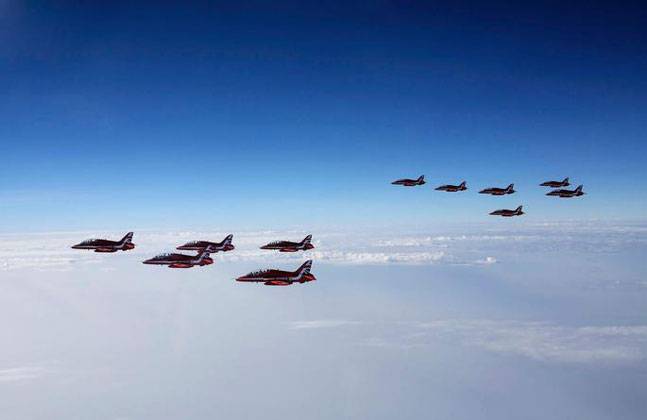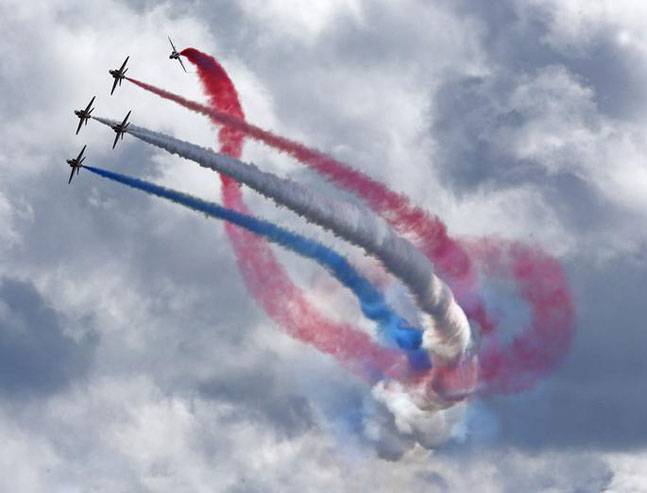On Indian Air Force's 84th Foundation Day, a guest from the West
The Royal Air Force's (RAF) renowned aerobatics display team, the Red Arrows which is on a world tour, reached the Indian Air Force (IAF) base at Hindon to perform at the 84th annual parade.

Weather, the single, most important factor has not been on their side just yet.
Despite arriving in India from Karachi in Pakistan on Monday, the Royal Air Force's (RAF) renowned aerobatics display team, the Red Arrows, could make it to the Indian Air Force (IAF) base at Hindon, outside the national capital only on Friday. Earlier, the scheduled touchdown for the 12 aircraft British team at Jaipur had to be changed last minute in favour of Ahmedabad, with weather playing truant.
For the 120-member crew of the Red Arrows, the environs at Hindon offer thinner air and a climate that is both 'warm and nice'. On Friday evening, at the end of a 'clear day' when they practiced - what else but formation flying - there were happy faces all around, finally. The team is on a world tour, its biggest in over a decade. They've embarked on a journey which, at its end, will have taken the crew to more than ten countries in over two months.
Based on a request from the RAF, the IAF agreed to let them have a go during the latter's 84th annual parade.
"My Commanding Officer (CO) had performed here in 2009 and it was his recommendation that we don't miss India at all," said Flight Lieutenant Joe Hourston who goes by the code 'Red 9', which designates the position of the aircraft he flies in the nine-aircraft display.

Technicians, tasked with keeping the 12 Hawk T1 jets, few of which were delivered way back in 1979, fit for the strain of formation flying have a smaller window on hand. Simply put, they were busy tightening the screws and literally adding colour.
Junior Engineering Officer, Flight Lieutenant Marcus Ramsden explained, pointing to the fuel pod located right at the centre of the aircraft's undercarriage, "The aircraft pumps the diesel in the smoke pod through the system which vapourises and exits the exhaust at temperatures in excess of 450 degree Celsius as white plume. If I mix red dye, it will give me red smoke and similarly for blue. In a sortie, we can generate five minutes of white, a minute of red and a minute of blue smoke". The colourful spectacle aside the synchronised exhaust is also a key marker for the pilots. It helps them assess the position of individuals in the formation and effect corrections, if required.
The IAF's equivalent of Red Arrows, Suryakiran Aerobatics Team is in the process of revival. It chose the Advanced Jet Trainer (AJT) available in the force, like the RAF did. They both arrived at the Hawk. "Our smoke generator pods are not yet in. Additional acquisition of the aircraft will cater for that," said an officer aware of the issue.
Based out of United Kingdom's Scampton base, made famous on account of the daring Dambusters raid in the Second World War, the Red Arrows was constituted in 1965. Till 1979, they relied on the Gnat aircraft. In its present avatar, with the Hawk, the Red Arrows are poised to carry on till 2030.

On the final day, poor visibility ensured the team could not participate in the parade. Plan B, the IAF's Suryakiran team, was operationalised.
Not to miss out, the Red Arrows put up a separate performance after the conditions eased out. The audience, by then, had departed.
Done at Hindan, the team headed east.
Weather, they prayed, be kind.
'Highest amount of flying in decades'
In his annual address, which was also his last, Air Chief Marshal Arup Raha declared that the IAF in 2015-16 had flown over 270000 hours which was the highest flying per year in decades. "It is over 40000 hours more than the average of all the years in the last decade," he added.
He also announced that the IAF had placed an order for 120 indigenously designed and built, Light Combat Aircraft Tejas. Incidentally, this year the Tejas performed for the very first time at the parade.
While recounting the disappearance of the Antonov 32 aircraft in July, Raha said the IAF 'shared the sense of loss and grief' of the kin of the 29 personnel who were on board. Terming the environment 'turbulent', Raha said the world looked at India as the net security provider in the Indian Ocean region.
The air chief also handed over to the awardees a Yudh Seva Medal, five Vayu Sena Medals (Gallantry), 16 Vayu Sena Medals and 29 Vishisht Seva Medals.
Writer is a senior special correspondent with India Today TV and tweets @jrpur
Also Read:
Air Force prepared to take up any challenge, says IAF chief Arup Raha